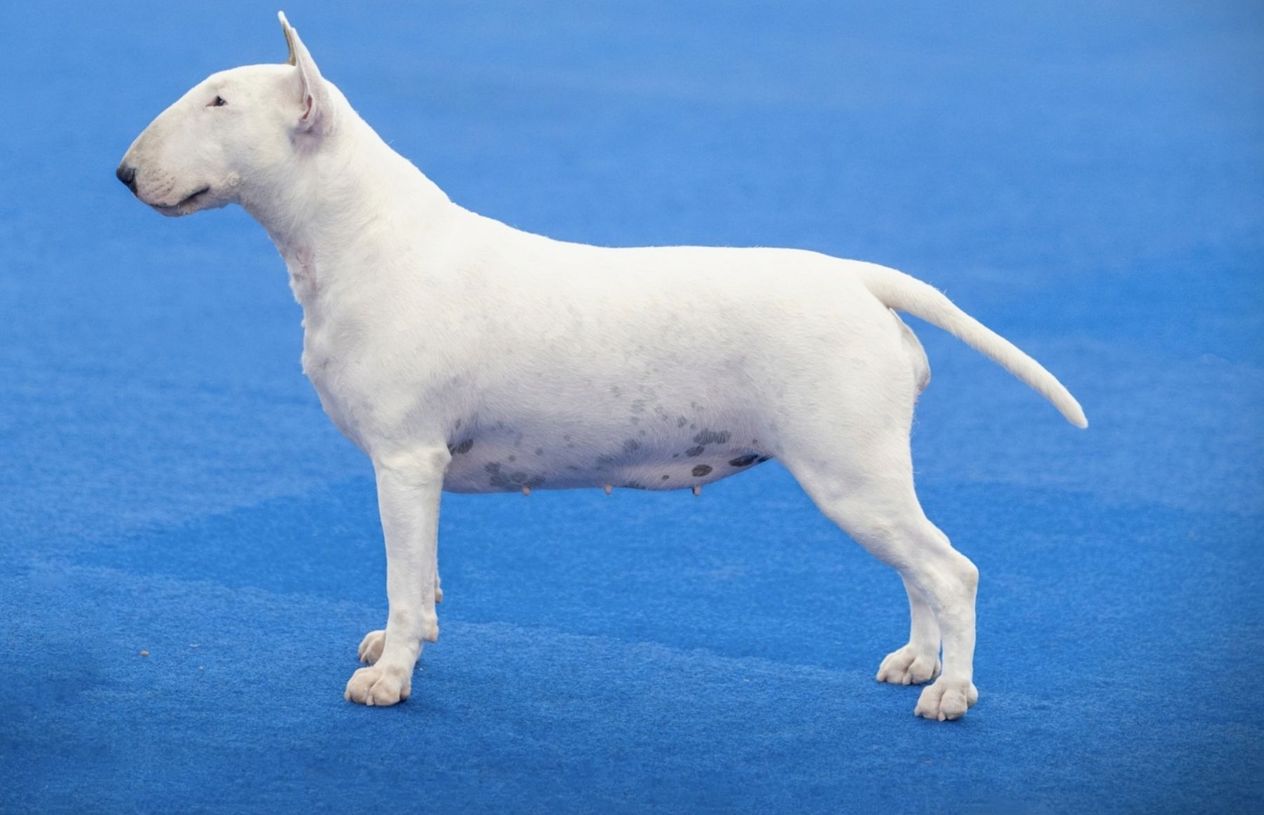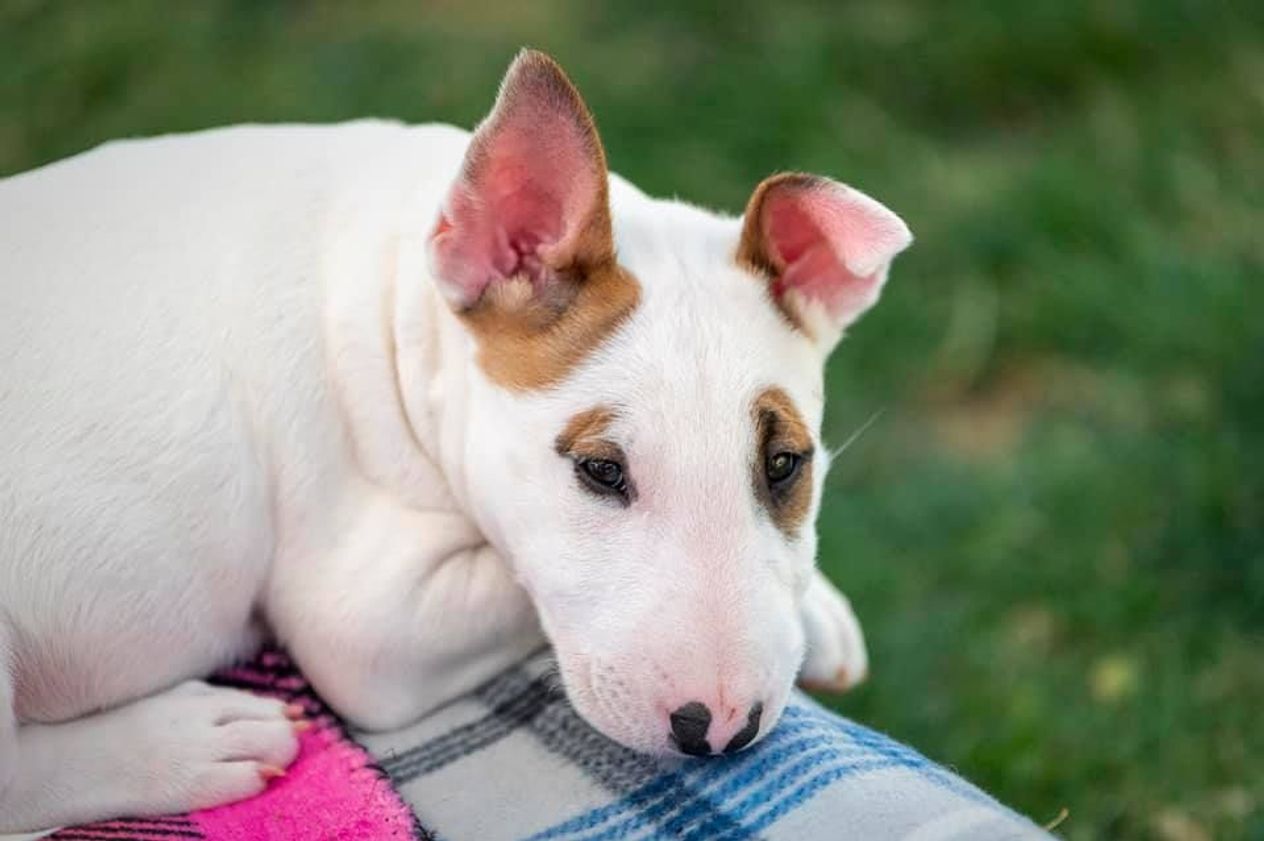Get to know
Bull Terriers

Veterinarian reviewed
The jaunty Bull Terrier is both comedic and classic, popular as a companion and mascot.
Browse available puppies
Connect with reputable breeders to find the dog of your dreams
At a glance
Moderate Energy
Energy level
3/5
Minimal Maintenance
Grooming
1/5
Large
Size
Playful, bold, comical
Temperament
12-13 years
Lifespan
Average Trainability
Training
3/5
Medium Vocality
Barking
3/5
At a glance
Energy level
Moderate Energy
Grooming
Minimal Maintenance
Size
Large
Temperament
Playful, bold, comical
Lifespan
12-13 years
Training
Average Trainability
Barking
Medium Vocality
Why people love the breed
Living with a Bull Terrier is like having a comedian for a roommate—one that always seems to be in trouble...
Appearance
The Bull Terrier is both handsome and comical in appearance, with a muscular sleek body that gives both the impression of power and agility.
Grooming
Grooming requires only occasional brushing and bathing.
Breed temperament and characteristics
Comedic, playful, and mischievous are words most often used to describe the breed.
Exercise
Bull Terriers are fairly high energy dogs that need to race around and find adventure every day.
Virtue Bull Terriers
Training
Bull Terriers are known for being stubborn, but they also like to please.
Diet and nutrition
Bull Terriers require no special dietary considerations except a good quality diet.
Old England Bull Terriers
Health issues
Bull Terriers, especially white ones, have some health concerns of which potential owners should be aware.
Lifespan: 12 to 13 years.
Atopic dermatitis (atopy)
In which allergies cause the skin to become inflamed and itchy.
Compulsive-like behaviors
These are more common in Bull Terriers.
Patellar luxation
In which the kneecap slips out of the groove in which it should be nested, causes lameness and arthritic changes. It occurs mostly in small breed dogs. Screening involves an examination and grading of the degree of luxation present registered with OFA.
Deafness
The inability to hear with either one or both ears being affected.
Other health issues
Other conditions include kidney disease, lethal acrodermatitis, cardiac disease, and lens luxation.
History
The Bull Terrier comes from fighting roots, but its history was changed midcourse to enable it to become a dashing companion dog.
About the author
Canine specialist, Caroline Coile, Ph.D., is the author of 34 dog books, including the top-selling Barron's Encyclopedia of Dog Breeds. She’s written thousands of magazine and web articles about dogs. She specializes in canine science, health, breeds and competitions. Caroline has won 20 national dog-writing awards, and was a 2015 Inductee into the Dog Writers Association of America Hall of Fame.
Veterinarian reviewed
Dr. Nate Ritter, DVM is the Veterinary Medical Director at Good Dog. He earned his Bachelor of Science in Biology from Lafayette College and his Doctor of Veterinary Medicine degree from Virginia-Maryland College of Veterinary Medicine. He is a member of the American Veterinary Medical Association, New York State Veterinary Medical Society, the Veterinary Medical Association of New York City, and the Society for Theriogenology. Additionally, he is a USDA-accredited veterinarian.
Breed Scorecard
Characteristics and temperament
Affectionate with family
3
Watchdog level
5
Playfulness
5
Adaptability
3
Social needs
4
Temperament
Playful, bold, comical
Intelligence
3
Good with other dogs
2
Good with cats or other pets
3
Friendly with strangers
3
Good as a service dog
3
Good for apartments
3
Barking level
3
Appearance
Height
21-22"
Size
Large
Colors
Fawn smut and white (non-standard), White and fawn smut (non-standard), White black and tan, Fawn (non-standard), Fawn and white (non-standard), Black brindle and white, Black tan and white, Brindle, Brindle and white, Red, Red and white, White, White and fawn (non-standard), Red smut (non-standard), Red smut and white (non-standard), White and brindle, Fawn smut (non-standard), White and red, Black brindle, White and red smut (non-standard), White and black brindle
Coat texture
Harsh
Coat length
Short, flat
Training
Trainability
3
Exercise
Exercise needs
3
Exercise time
About 1 hour daily
Mental exercise needs
4
Favorite activities
Tugging, weight pulling
Grooming
Grooming needs
1
Brushing frequency
Monthly
Needs professional grooming?
No
Drooling level
1
Health issues
Atopic dermatitis (atopy)
Compulsive-like behaviors
Patellar luxation
Deafness
Other health issues
Other
Bred for
Fighting, then companion
Country of origin
England
Popularity level
3
FAQs
On Good Dog, you can search for Bull Terrier puppies or dogs in rescues and shelters. Adopting a Bull Terrier from a shelter or rescue is generally less expensive than buying a puppy from a breeder with ethical practices. Across the United States, there are dedicated rescues that specialize in specific breeds and may even help transport a Bull Terrier dog to you from another part of the country. Although it can be more cost-effective, adopting the exact breed you're looking for is typically more difficult than working with a responsible breeder. Learn more about adopting a dog from a shelter or rescue.
They’re good watch dogs, and will bark at an intruder, but they were not bred to be guard dogs and are not usually protective toward property.
Yes. They are playful, fun-loving, and affectionate.
It varies with the individual, but most enjoy cuddling to some extent—especially when it’s cold out.
Prices for Bull Terrier puppies for sale vary by breeder and individual puppy. On Good Dog today, Bull Terrier puppies are typically around $2,750. Because all breeding programs are different, you may find dogs for sale outside that price range.



